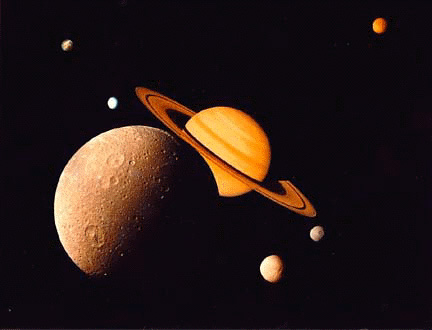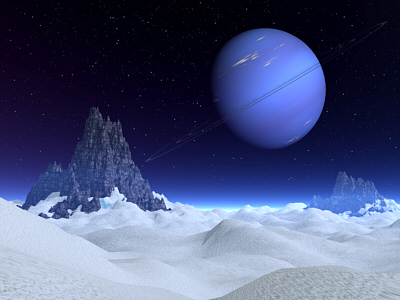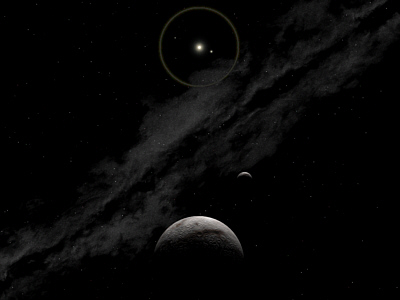
PLANET SATERN RINGS
...and so, on we fly to the 6th planet: The Saturn System.

Saturn the planet, like Jupiter, is not our interest for bases. But Saturn the planet is surrounded by 4 medium
size moons, 3 small ones and Titan, a large one (with an orange atmosphere!). This is our first time finding medium size
moons, recalling that Earth's and Jupiter's are size large, while Mars' were small.

The 4 medium size moons, Rhea (shown here with Tethys in the background), Iapetus and Dione all are made
of rock and ice. All Saturn's moons are good for bases, as Saturn emits no radiation. We won't be terraforming
any of these kinds of moons (which are like our own, only smaller) anytime soon, however, they are usable as outposts
and bases, which is good enough. Notice that Saturn itself gives off as much light as the sun in this area of our Solar Neighborhood.

Here is Dione, shown with its interesting streaks left over from early ice volcanoes that are now quiet.
We are lucky to be alive at this time, when our Solar System is much, much quieter than it used to be!

Another look at a possible future method of making larger human colonies on these worlds- literally re-creating Earth
there, under a bubble structure. This is a solar and electric powered colony on Tethys. Note the organic network of
geodesic spheres and transportation conduits linking the habitats located outside the central dome.

Here we see the rock and ice environment of these four medium moons, on Iapetus.
This moon looks at the planet's rings dead on, and we see two
of the small moons there: Enceladus, and near the rings, Mimas.

"And man shall have dominion over the Earth and the animals."
This is Enceladus, the brightest moon in the Solar System. The way to set up bases on these moons will be to
prepare the ship that makes the trip out to double as the core of the future base when it lands. Here we see such
a ship arriving to start a new lunar base in the Saturn System, carrying humans out towards our destiny of solar dominion.
In 2006 NASA scientists discovered that this moon may harbor life in some simplistic form, in the exaust vents such as the one here.

Mimas orbits very close to Saturn, but not among the rings. It is small and here we see the closest near miss to destruction
anywhere: the shot that almost shattered this moon in the far distant past. Astronomers sometimes call it 'The Death Star'
after Star Wars, and it is a reminder that Saturn's ring itself was probably a moon destroyed in the past. And finally...

...orbiting the Lord of the Rings from a distance is the grand finale of the Saturn System, the giant moon Titan. 3/4 the size of Mars and larger than the planet Mercury, Titan is another one of those special places, like Mars, that already has a substantial atmosphere, continents and seas, under its orange sky. So, this is another place that can be more than just a base-- it is a place that can be terraformed into an eventual human friendly world.


Already, Titan has excited interest among astronomers. In 2005 these scenes really took place, as the American Cassini
spacecraft from Earth entered orbit around Titan and sent down this, the European Titan Christiaan Huygans probe, to 'test the waters.'
It found the continents and is examining the composition of Titan's seas.
...and on we fly, to the 7th planet: the Uranus System...

The Uranus System is twice as far out from the sun as the Saturn system. But once we have gotten this far, our ships will certainly have the capability for very fast travel. It took Voyager six months to get to Jupiter and 3 years to get to Saturn. By the time we colonize the Moon, Mars, the Jupiter and the Saturn Systems, the Uranus System will definitely be "nearer" than it is today. What will we find there? First of all, the planet itself is weird: Uranus is tilted on its side and the moons orbit 'north and south' instead of 'east and west.' It has a thin set of rings and five medium size rock moons (resembling Saturn's four medium ones)...
...giving us a firm place to land. In order of size, they are Titania, Oberon, Umbriel, Ariel and Miranda.
In this view is Oberon, with Miranda above it and Titania to the right, which is really 'south.'

Two of the five, Oberon and Umbriel reflect very little light and have dark surfaces, as we can see by this view of Umbriel.
Ariel and Titania (largest-upper left) are lighter. All four have about the same value as future outposts.

Just like before, new explorers and voyagers will build bases among the moons of Uranus.
Here we see two pioneering ships arriving in the Uranus System passing not one of the five medium sized moons
(which is their destination), but one of the smaller moonlets, only miles across, that make up the majority of the natural satellites around all the gas giants.

In this view we see Titania, the largest moon in the Uranus System, with an edge on view of the pretty
planet and its sister moons, Ariel, Umbriel in the middle and Oberon below that.

Here we see a base on the darker colored moon (Oberon or Umbriel- they both look pretty much alike!) It is easy to assume
that once 'moonbase' technology is widespread from Earth to Saturn, to 'adventure' is added 'experience' in pioneering.

What will humanity be like in the future? Will they scoff at us today like we scoff at Medieval people? Or will they remember the truth of how they got to be a spacefaring civilization? It may be fitting to, once we are out here, remember our past. We may not get to Uranus for the next 150 years (2250), but imagine, will some united human government pay their respects to the first nation in space (Russia- Sputnik 1957) by building a base that is more than just utilitarian? I think we can all hope that we will one day be vindicated as the greater angels of our nature prevail against fear and inability. It is our destiny, in this generation, to begin settling the cosmos.
...and onwards we fly, to the 8th planet: the Neptune System

And onwards we fly.
The 8th planet is Neptune. Doubly as far as Uranus, but about the same color and composition.
It took Voyager 12 years to get to Neptune from Earth (1977-1989). But what surprises Neptune has for us!
A few small moonlets, Nereid (above) which is barely a moon, and then one big one. On approach we find Nereid
here, in its erratic orbit far from the planet. Nereid is not a good candidate for a base, mining only, since it is irregular and small.
In fact, Neptune does not have any moons that are suitable for human bases, except one:

Triton.
Triton is bigger than any moon of Uranus, in fact it is the size of Pluto- and probably knew Pluto once, because Triton was a so-called
'trams-Neptunian object) but got caught in Neptune's gravity and became a moon instead. Triton has ice guysers and is especially
cold because it is so white in color and reflects most light back into space. What is Triton like on the surface?

Rock and super cold ice. The beautiful planet gives a blue radiance to its large
moon's landscape. Our base here will need a good heater.

Triton has many terrains (remember it is the size of a small planet), and here we see one of the amazing
ice volcanoes firing out matter into a plume that falls back to the surface. These plumes of ice
amazed scientists on Earth when Voyager discovered them in 1989.

Triton's elongated orbit takes it closer and further from Neptune depending, and it also orbits in reverse of all the
other moons in the Solar System, since it didn't originate from Neptune naturally, but was caught by the planet's
gravity from deep space. Here, US, European and Russian people have built a base underground.
...And on to the 9th planet, Pluto

Human Beings are in for a long run in colonizing the Solar Neighborhood, but even that has an end point.
Our star system is finite. Here at the end of our Grand Tour, we find the 9th planet, Pluto.
All alone with its moon, Charon and two newly discovered moonlets, orbiting the Sun once every 248 years.
Pluto and Charon are just fine for a base, they do not (so far as we know) have any geological
problems, but they are just very remote. Here we see the sun as just a very bright 'star' in the sky.
The other bright object is mighty Jupiter, outshining even Neptune with its sheer size.

At the end of the road are these two sentinals, and here we see Pluto's thin atmosphere crystalizing as ice and
falling to the surface during the long winter... and Charon, hanging quite large in the sky, making its doleful rounds.
Since both are rotating at the same speed, Charon would always be right where it is now, only the background of deep space
would change, and the light from the sun. If you wanted to see a different view of Charon from Pluto, you would have to move yourself.

Yet even here, our Plutonic outpost will someday reign.
From here on Charon, we see Pluto and behind it the vastness of Interstellar space.
Pluto, along with the other planetoid objects such as Sedna and Quaoar, marks the beginning of the
essential border area between Interplanetary space, which we have now colonized, and Interstellar space...
the unfathomable emptiness between the stars.
Here at the end, take time for one last message:
We always talk about aliens, disasters and the difficulty of conquering space. It makes us afraid of it.
"The aliens are more advanced than us."
"I don't want to get abducted by aliens."
"Space is scary."
Yes it is.
It will take confidance to live out our dreams.
But if we have what it takes, then one day,
when we come face to face with another being in the cosmos,
it won't be an alien at all:
